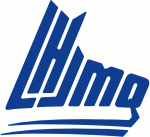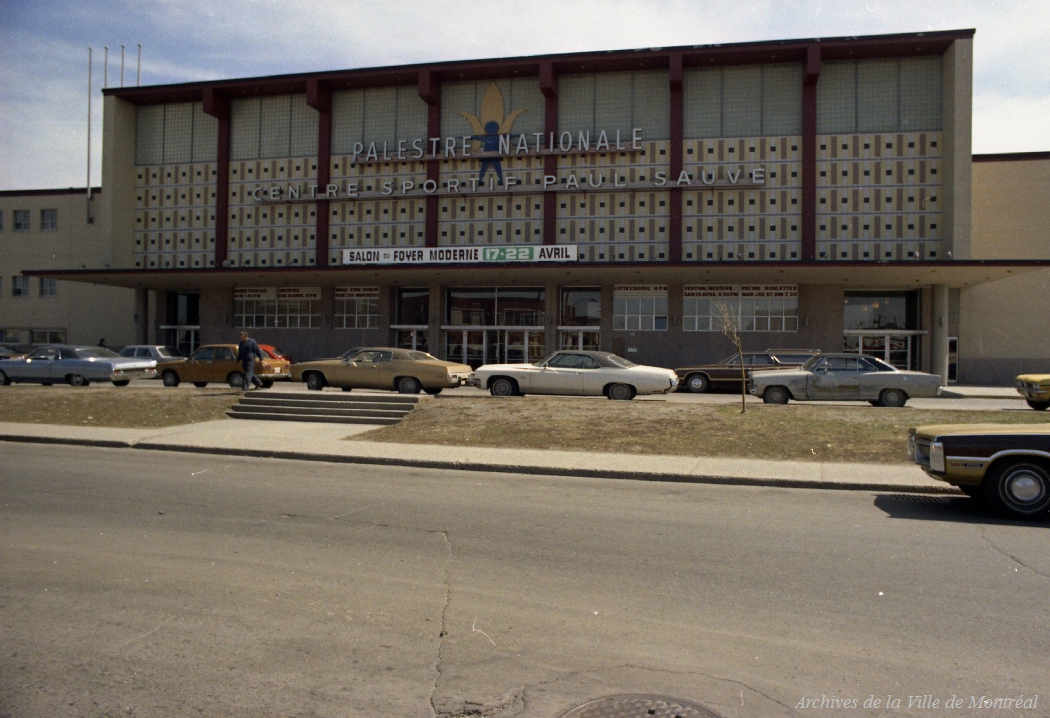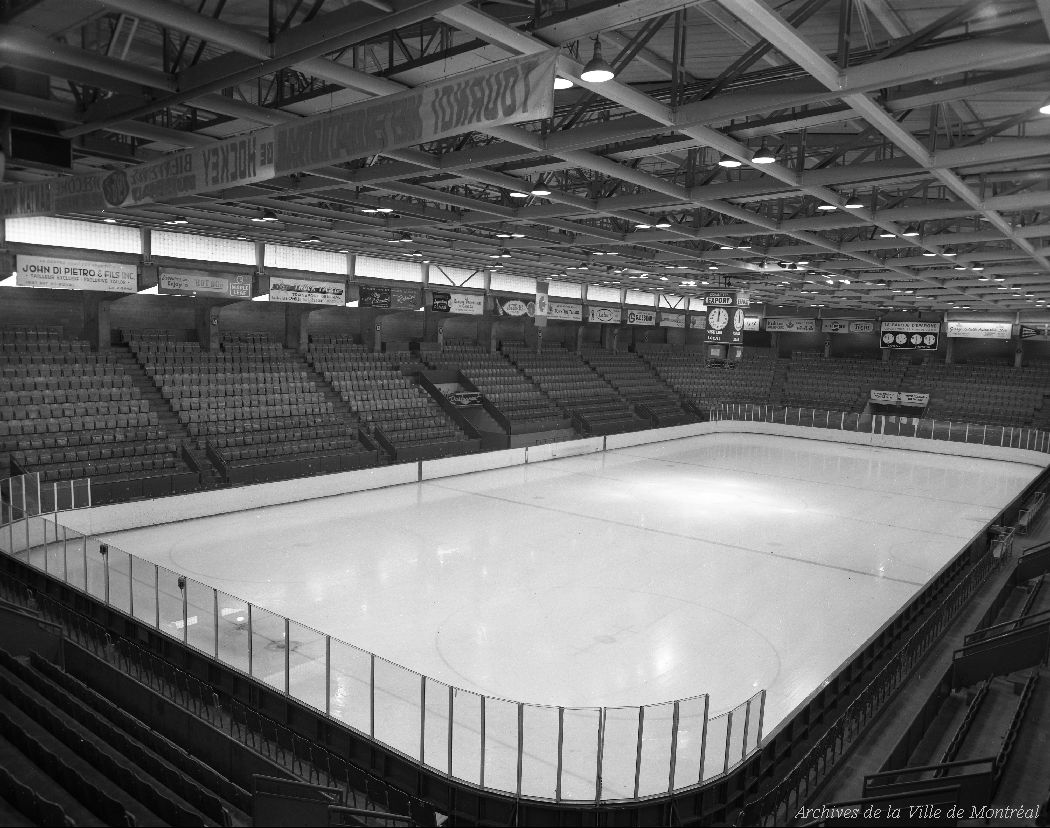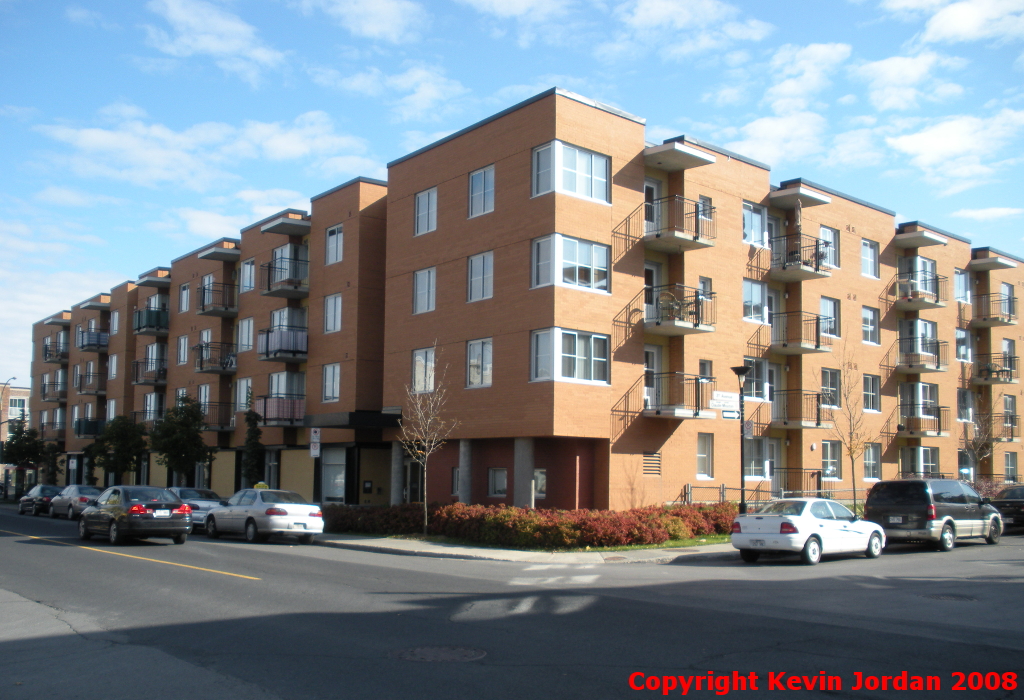
Montreal Juniors
Arena Name: Paul Sauvé Arena
Capacity: 4,100
Built: 1960
Last Game: 1982
Demolished: 1992
Address: 4000, rue Beaubien Est, Montreal, QC, H1X 3M8
Ice Surface Size: Regulation

Paul Sauvé Arena

What's the Arena Like?
Historical photographs on this page provided by the Archives of the City of Montréal.
Paul Sauvé succeeded the legendary Maurice Duplessis in office as Premier of Quebec and held the post for only four months before dying in office of a heart attack. Paul Sauvé's untimely death came just before the opening of Montreal's new East End arena in the borough of Rosemont, and so the building was named in his honour. Opening in 1960, the arena complimented the West End's Verdun Auditorium as one of Montreal's "second arenas" after the Forum. The complex included a 4,100 seat amphitheatre, curling rink, bowling alley, a gymnasium and a restaurant.
The QMJHL played at Paul Sauvé Arena on a couple of occasions. One of the Q's founder teams, the Rosemont National, opened the league's inaugural season there, but only lasted two years before bowing out. Later on, the Montreal Juniors (the original version descended from the Montreal Junior Canadiens) played out of Paul Sauvé for three more years, from 1979-82.
Paul Sauvé Arena had a colourful history during its 32 years. In addition to hosting hockey, the building was also home to some of Quebec's most important political moments, including acting as the referendum night headquarters for the "Yes" forces in 1980. The building hosted Olympic volleyball in 1976, and was also known as the spiritual home of wrestling in the province, as a weekly fight card was hosted at the rink for many years.
By the early 1990's, the building had become dilapidated and the land was becoming more and more valuable as real estate prices in the East End skyrocketed. With Maurice Richard Arena only a few blocks away, the decision was made to demolish the arena, and it was done over the summer of 1992. Many internet sources incorrectly list a 1996 demolition date, but 1992 is correct - see Geoff Baker's article in the Montreal Gazette of May 14, 1992. Construction of the new housing complex on the site commmenced in April of 1994, and there is no trace of the arena's presence on the site today.
Richard T says:
My father and I first visited the Paul Sauvé Arena in the late 60's, early 70's to attend their Monday night wrestling matches that pitted the "bad guys" (Killer Kowalski, Abdullah the Butcher, the Vachon brothers - Maurice Mad Dog and Paul, etc.) against the "good guys" (Edouard Carpentier, the Rougeau brothers- Jean and Jacques, etc).
We soon discovered a "junior" hockey team, les Bombardiers de Rosemont (the Rosemont Bombers) played their games at the arena and began following them quite closely. At the time that le National de Rosemont was formed, I thought the Bombardiers had "morphed" into le National but perhaps they were two different teams playing in two different leagues; I do know the Bombardiers disappeared when le National came onto the scene. I seem to recall that the original owner of le National was the wrestler Jean (Johnny) Rougeau.
I believe le National de Rosemont takes its name from la Palestre Nationale which I think (owned?) (operated?) the Paul Sauvé Arena at the time. From what I read, la Palestre Nationale's original name was the AAAN ( l'Association Athletique Amateur Nationale - the National Amateur Athletic Association) but became known as la Palestre Nationale. They moved their operations to the Paul Sauvé Arena when it was built in 1960 but I am not sure what role la Palestre Nationale played in the construction of the arena. Did the city pay for the construction and the Palestre operated it or did la Palestre pay for its construction? I distinctly recall seeing many donor plaques in the arena lobby which leads me to believe that la Palestre Nationale led a campaign to raise funds for the construction of the arena- don't know whether this means they were the owners. La Palestre continues to exist despite the demolition of the arena but I believe they presently exist as a sports foundation, raising funds and distributing them to amateur athletes.
As for the arena itself, I recall it being a nice comfortable modern facility, located in a working class area of Montreal which had a "small town" feel to it. And with a 4,100 capacity, the arena was ideally suited for junior hockey. I don't quite understand why le Nationale de Rosemont didn't work at the Paul Sauvé Arena but I do know that when other junior hockey teams tried to use the (relatively) nearby Maurice Richard Arena, it flopped, partly because the Maurice Richard arena has no character- it's a huge building with a capacity of about 4700, but with a very high ceiling that kills any fan enthusiasm- it's a really "cold" place, not temperature-wise but team spirit-wise.
Coming back to the Paul Sauvé Arena, I was quite surprised to read on your site that the arena was demolished in 1992, after only 32 years of existence. I attended a few volleyball games played at the arena for the Montreal Olympics in '76 and am sure the arena had been upgraded/renovated for this purpose. To hear that it had deteriorated to the point of requiring demolition, a mere 16 years after this renovation, is surprising. There may have been a few other issues at play. As you say, perhaps the need for space for social housing and the (relative) proximity of another large arena (Maurice Richard Arena, also built in 1960), convinced the politicians that the arena should be demolished. There was also a new arena built nearby for the 1976 Olympics (Etienne Desmarteau Arena at 3430 Bellechasse Street) that perhaps made the Paul Sauvé Arena redundant. Regardless of the reasons, I think it was a real shame that the arena was demolished.
A few closing remarks about le Nationale de Rosemont. I continued to follow le Nationale after it moved to Laval. Small anecdote- during their first or second season in Laval, they had an electrical problem during a game at the Colisee de Laval. All the lights went out and the game had to be postponed. It was played the following evening at.... the Paul Sauvé Arena! (As an aside, the Colisee de Laval was/is much more dingy than the Paul Sauvé Arena ever was). I visited the Colisee de Laval a few years ago, a number of years after the team had relocated to PEI. The Laval teams had produced quite a few outstanding NHL players, Mike Bossy and Mario Lemieux as well as Robert Sauvé (goalie with Buffalo) and many others. I was saddened to see that little of this history is depicted in the present day arena. There was one large photo of Mario Lemieux in the lobby but nothing else. I'm a fan of junior hockey and would hope that communities would continue to display their rich junior hockey heritage even when a team relocates.
Inside Paul Sauvé Arena

What's the Arena Used for Today?
Paul Sauvé Arena was demolished in 1992 and a low-rise housing complex was built on the site. As of the last time I visited, there was no trace of the old arena on site.
The Site of Paul Sauvé Arena

Feedback
If anything is incorrect or you have something to add, please e-mail me at  and I'll update the guide.
and I'll update the guide.
 and I'll update the guide.
and I'll update the guide.Copyright © QMJHL Arena Guide, 2002-19.
All rights reserved.
Last Revised: December 19, 2019